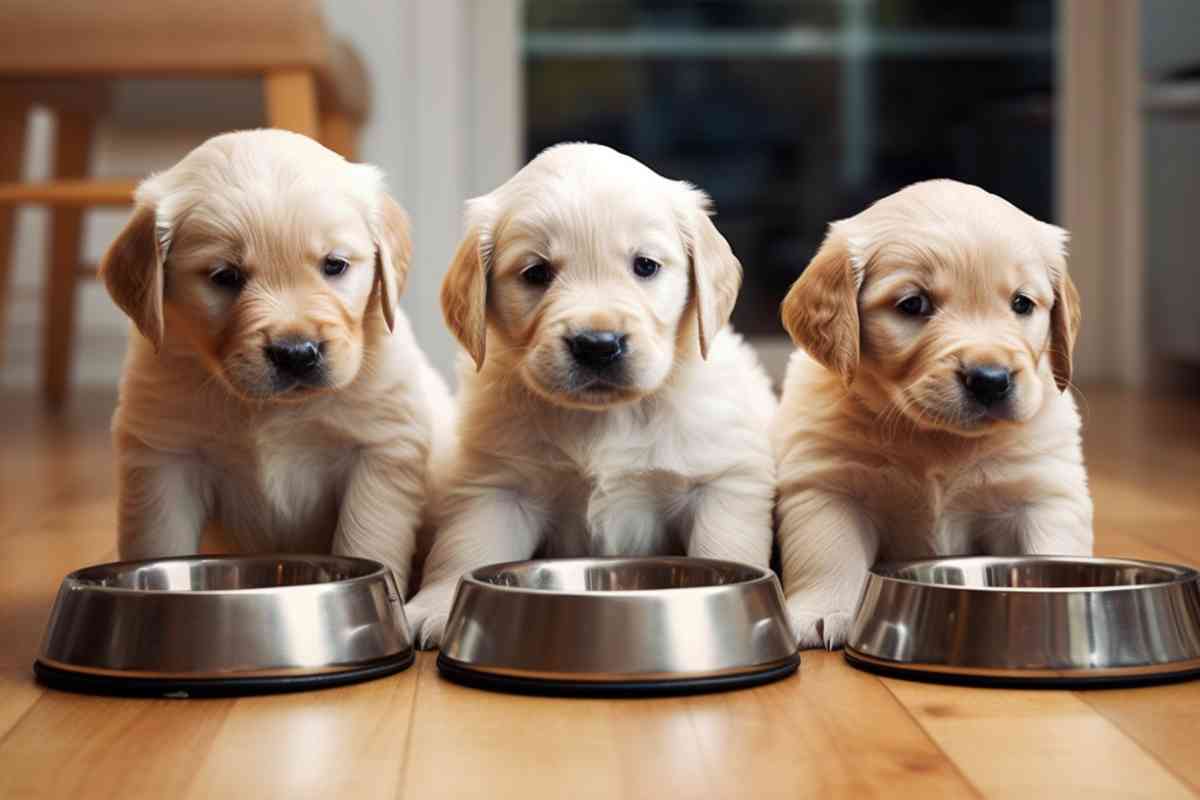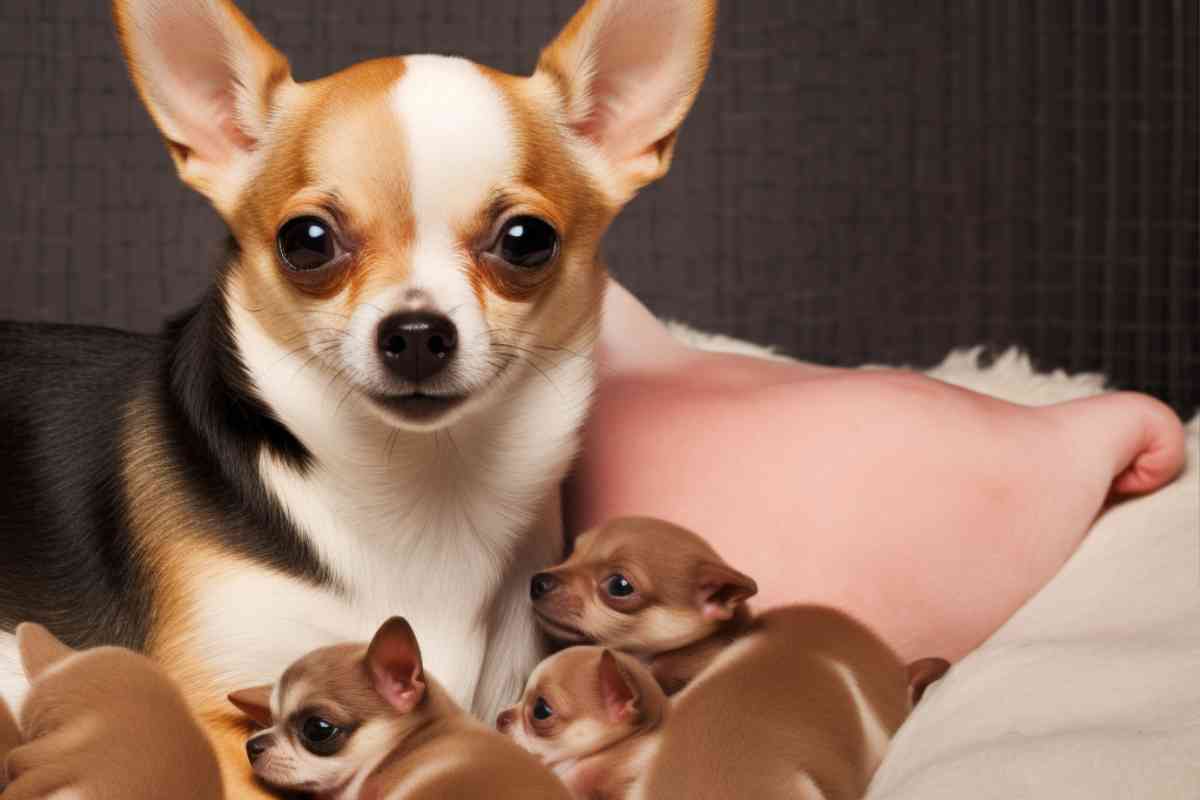How Often Should 5 Week Old Puppies Eat: A Guide to Proper Puppy Feeding
Navigating the world of puppy care can be a joyous yet challenging journey, especially when it comes to feeding schedules. As your puppy grows, their dietary needs change rapidly. This article focuses on a crucial stage in your puppy’s life – the five-week mark.
At this age, puppies are transitioning from mother’s milk to solid food, a process that requires careful management to ensure they’re getting the right nutrients in the right amounts. We’ll guide you through this important phase, providing expert advice on feeding frequencies, portion sizes, and the type of food your five-week-old puppy should be consuming. Let’s set your puppy on the path to healthy growth and development.

How Often Should 5 Week Old Puppies Eat?
At five weeks old, puppies are transitioning from milk to solid food. They should be fed a gruel mixture, which is a blend of high-quality puppy food and a puppy milk replacer. This gruel should be offered in small, frequent meals approximately five times a day. This frequent feeding supports their rapid growth and high energy needs. As the week progresses, the gruel should be gradually thickened, preparing the puppies for the introduction of dry kibble in the coming weeks.
Here’s everything you need to know about feeding a five-week-old puppy.
Starting water for the first time too? Here’s what you need to know about offering your pup water, and whether leaving water out all of the time is the right move.
Worried about your pup’s diarrhea, even though your vet says it’s normal after deworming? This guide will tell you what you need to know about diarrhea after deworming.
How Often Should 5 Week Old Puppies Eat?
Five-week-old puppies should eat approximately five times a day. At this age, they’re transitioning from mother’s milk or a milk replacer to a diet of solid food. This transition is facilitated by introducing a gruel mixture, which is a blend of high-quality puppy food and a puppy milk replacer, creating a thin, soupy mixture.
The gruel should be offered to the puppies in small, frequent meals throughout the day. A typical feeding schedule might include meals at early morning, mid-morning, lunchtime, mid-afternoon, and dinner time. This frequent feeding supports the puppies’ fast growth and high energy needs.
As the week progresses, the gruel should be gradually thickened by adding less liquid, helping the puppies adjust to the texture of solid food. By the end of the fifth week, the gruel should be quite thick, preparing the puppies for the introduction of dry kibble in the coming weeks.
Remember, it’s important to monitor each puppy to ensure they’re eating enough and not experiencing any digestive issues. Digestive issue are the highest recorded problems among dogs, so you want to start your pup off right.

Feeding Schedule for a Five-Week-Old Puppy
At five weeks old, puppies are in the process of transitioning from milk to solid food. Here’s a typical feeding schedule:
- Early Morning (6-7 AM): Feed the puppy a portion of the gruel mixture. This is made by blending a high-quality puppy food with a puppy milk replacer to create a thin, soupy mixture.
- Mid-Morning (9-10 AM): Offer another portion of the gruel mixture.
- Lunch (12-1 PM): Feed the puppy another portion of the gruel mixture.
- Mid-Afternoon (3-4 PM): Offer another portion of the gruel mixture.
- Dinner (6-7 PM): Feed the puppy another portion of the gruel mixture.
- Late Evening (9-10 PM): Offer a final portion of the gruel mixture for the day.
Remember, the gruel should be gradually thickened over time by adding less liquid, helping the puppy adjust to the texture of solid food. By the end of the fifth week, the gruel should be quite thick.
Fresh water should always be available for the puppy, even though they’re still consuming a lot of liquid through their diet. It’s important for them to start getting used to drinking water.
Always monitor your puppy to ensure they’re eating enough and not experiencing any digestive issues.
How Much Should a Five Week Old Puppy Eat?
Feeding amounts for a five-week-old puppy vary greatly depending on the breed and expected adult size of the puppy. Here are some general guidelines:
- Small Breeds (Expected Adult Weight Under 20 lbs): Small breed puppies grow quickly and may start eating solid food sooner than larger breeds. They may consume between 1/4 to 1/2 cup of puppy gruel per meal.
- Medium Breeds (Expected Adult Weight 20-50 lbs): Medium breed puppies may consume between 1/2 to 1 cup of puppy gruel per meal.
- Large Breeds (Expected Adult Weight Over 50 lbs): Large breed puppies grow slower than smaller breeds but have a longer growth period. They may consume between 1 to 2 cups of puppy gruel per meal.
Remember, these are general guidelines and individual puppies may have different needs. The gruel should be made from a high-quality puppy food and a puppy milk replacer, and should be offered to the puppies in small, frequent meals throughout the day.
Always monitor your puppy to ensure they’re eating enough and not experiencing any digestive issues.

Transitioning a Puppy from Milk to Solid Food
The transition from milk to solid food, a process known as weaning, is a crucial phase in a puppy’s life. This process typically begins when puppies are about 3-4 weeks old and continues until they’re 7-8 weeks old. Here’s a detailed guide on how to do it:
- Introduce a Gruel Mixture (Start at 3-4 Weeks): The first step in weaning is to introduce a gruel mixture. This is made by blending a high-quality puppy food with a puppy milk replacer to create a thin, soupy mixture. Let the puppies explore the gruel. They might walk in it, play in it, or even start to lap it up. This messy exploration is a normal part of the process.
- Gradually Thicken the Gruel (4-5 Weeks): Over the next few weeks, gradually thicken the gruel by adding less liquid. This helps the puppies adjust to the texture of solid food. By around five weeks old, the puppies should be eating this thicker gruel comfortably. They should still have access to their mother’s milk or a milk replacer, but the gruel should start to become a more significant part of their diet.
- Introduce Dry Kibble (5-7 Weeks): Once the puppies are happily eating the thickened gruel, start introducing dry kibble. You can do this by mixing some into the gruel. The kibble can be moistened with a bit of warm water to make it easier for the puppies to eat.
- Transition to Solid Food (7-8 Weeks): Gradually reduce the amount of water or milk replacer you’re adding to the kibble. By around 7-8 weeks old, the puppies should be eating the dry kibble completely.
- Gradually Reduce Milk Feedings: As the puppies eat more of the gruel and kibble, start to reduce the number of milk feedings. By around 7-8 weeks old, the puppies should be weaned off milk completely.
Throughout this process, it’s important to monitor each puppy to ensure they’re eating enough and not experiencing any digestive issues. If a puppy seems to be struggling with the transition, consult with a vet. They can provide personalized advice based on the puppy’s specific needs.
Sometimes introducing foods or supplements that introduce helpful bacteria can make a huge difference, according to research. A fresh food like Nom Nom can also be extremely helpful.
Fiber can also make a big difference in improving a puppy’s digestion, improving diarrhea in many animals. An anti-inflammatory medication can also be used if the issue doesn’t improve.
Remember, this is a gradual process and each puppy may progress at their own pace. Patience and consistency are key to a successful transition from milk to solid food.

What should 5 week old puppies be eating?
At five weeks old, puppies are in the process of transitioning from mother’s milk or a milk replacer to solid food. Here’s what a five-week-old puppy should be eating:
- Gruel Mixture: The transition to solid food is facilitated by introducing a gruel mixture. This is made by blending a high-quality puppy food with a puppy milk replacer to create a thin, soupy mixture. The gruel should be offered to the puppies in small, frequent meals throughout the day.
- Gradually Thicker Gruel: As the week progresses, the gruel should be gradually thickened by adding less liquid. This helps the puppies adjust to the texture of solid food. By the end of the fifth week, the gruel should be quite thick, preparing the puppies for the introduction of dry kibble in the coming weeks.
- Fresh Water: Fresh water should always be available for the puppy, even though they’re still consuming a lot of liquid through their diet. It’s important for them to start getting used to drinking water.
- New Foods. Tablescraps can benefit dogs’ health, so get your pup started on soft, appropriate table scraps like steamed carrots and boiled eggs early on.
Can Puppies be Weaned Onto Raw Food?
The decision to wean puppies onto raw food is a personal one and should be made in consultation with a veterinarian or a canine nutritionist. There are differing opinions on this topic.
Some believe that a raw food diet can provide dogs with a healthier coat, cleaner teeth, and higher energy levels. Science does support the value of a meat-based diet. However, others caution that raw diets might not be balanced and could lead to nutritional deficiencies or excesses. There’s also a risk of bacterial contamination with raw foods.
If you decide to wean your puppy onto a raw food diet, here’s a general guideline on how you might do it:
- Consultation: Speak with a veterinarian or a canine nutritionist to ensure that the diet you’re planning is nutritionally balanced for a growing puppy.
- Gradual Transition: Start by mixing a small amount of the raw food with their current food. Gradually increase the amount of raw food while decreasing the amount of their old food over a period of 7-10 days. This can help avoid digestive upset.
- Balanced Diet: A raw food diet for puppies should include muscle meat (often still on the bone), bone (either whole or ground), organ meats (like liver and kidneys), vegetables and fruits, and sometimes dairy, like yogurt.
- Proper Handling: Raw food should be handled with care to prevent bacterial contamination. Wash your hands and any surfaces or utensils thoroughly after they come into contact with raw food.
- Monitor: Keep a close eye on your puppy during the transition. If you notice any signs of illness or discomfort, such as vomiting, diarrhea, or loss of appetite, contact your vet immediately.

What if my five-week-old puppy doesn’t like gruel?
If your five-week-old puppy doesn’t seem to like the gruel, there are a few strategies you can try:
- Change the Consistency: The puppy might not like the texture of the gruel. Try making it thinner or thicker to see if the puppy prefers a different consistency.
- Change the Temperature: Some puppies might prefer their food slightly warm, as it’s more similar to mother’s milk. Make sure the food is not too hot, as it could burn the puppy’s mouth.
- Try a Different Puppy Food: The puppy might not like the taste of the puppy food you’re using in the gruel. Try a different brand or flavor of high-quality puppy food.
- Hand Feeding: Try offering the gruel on your finger. The puppy might be more willing to try it from your hand.
- Gradual Introduction: If the puppy is still nursing, try mixing a small amount of the gruel with the milk replacer. Gradually increase the amount of gruel over time.
Monitoring Your Puppy’s Growth and Development
As a responsible pet owner, it is important to monitor your 5-week-old puppy’s growth and development to ensure that they are healthy and thriving. Here are some factors to consider when monitoring your puppy’s growth:
Weight Gain
At 5 weeks old, your puppy should be gaining weight at a steady rate. According to Smarter Pup Training, a healthy weight gain for a puppy of this age is between 0.5 to 1 pound per week. However, every puppy is different, and weight gain can vary depending on the breed, size, and gender of your puppy.
To monitor your puppy’s weight gain, you can use a digital scale to weigh them once a week. Keep a record of their weight in a notebook or on your phone to track their progress.
Size
In addition to weight gain, you should also keep an eye on your puppy’s size. A healthy 5-week-old puppy should be growing steadily and proportionally. If you notice that your puppy is not growing at the same rate as their littermates or seems significantly smaller or larger than average, it may be a sign of an underlying health issue.
Growth and Development
Your puppy’s growth and development go hand in hand. As your puppy grows, they should also be hitting important developmental milestones. According to the American Kennel Club, some developmental milestones for a 5-week-old puppy include:
- Beginning to interact with their littermates and humans
- Starting to play and explore their environment
- Developing their sense of smell and hearing
- Beginning to stand and walk
If you notice that your puppy is not hitting these milestones or seems to be lagging behind their littermates, it may be a sign of a developmental issue.
How many hours can a 5 week old puppy go without eating?
A five-week-old puppy is still very young and needs frequent meals to support their rapid growth and development. Generally, they should be fed every few hours, around five times a day. This means they shouldn’t go more than 4-5 hours without eating during the day.
However, at night, they can usually go a bit longer without a meal. A healthy five-week-old puppy can typically go up to 6-7 hours overnight without eating.
It’s important to note that these are general guidelines and individual puppies may have different needs. If a puppy seems hungry more often, isn’t pooping often enough, or is not thriving, it’s important to consult with a vet. They can provide personalized advice based on the puppy’s specific needs.
Also, remember that hydration is crucial. Puppies should always have access to fresh water, even if they’re primarily still consuming liquid through their diet.

Feeding a Malnourished Five-Week-Old Puppy
Feeding a malnourished puppy requires special care and attention. Here’s a guide on how to do it:
- Consult a Vet: The first step is to consult with a vet. They can assess the puppy’s condition, provide a feeding plan, and monitor the puppy’s progress. They may also recommend specific diets or supplements to help the puppy recover.
- Small, Frequent Meals: Start by feeding the puppy small, frequent meals. This can help prevent overloading their digestive system. The meals should be a balanced puppy food, ideally one designed for recovery or growth.
- Introduce a Gruel Mixture: At five weeks old, the puppy should be starting the transition from milk to solid food. Introduce a gruel mixture made by blending a high-quality puppy food with a puppy milk replacer.
- Gradually Increase Portions: As the puppy’s condition improves, gradually increase the portion sizes. This should be done slowly to avoid overfeeding, which can lead to other health issues.
- Monitor Progress: Keep a close eye on the puppy’s progress. Look for signs of weight gain, increased energy levels, and improvements in coat condition. Regular vet check-ups are also important to monitor the puppy’s health and adjust the feeding plan as needed.
- Hydration: Ensure the puppy has access to fresh water at all times. Dehydration can complicate recovery from malnutrition.
Can a five week old puppy be separated from its mother?
While a five-week-old puppy is starting to gain some independence, it’s generally not recommended to separate them from their mother at this age. Puppies gain significant benefits from staying with their mother and littermates until at least eight weeks of age. Here’s why:
- Nutrition: While five-week-old puppies are starting to transition to solid food, they still rely on their mother’s milk for essential nutrients.
- Socialization: Interacting with their mother and littermates teaches puppies important social skills. They learn how to communicate, play, and behave appropriately with other dogs.
- Behavioral Development: Puppies learn a lot from their mother, including important behaviors like bite inhibition.
- Immunity: Puppies receive antibodies from their mother’s milk, which helps protect them against diseases until they’re old enough for vaccinations.
If a puppy must be separated from its mother at five weeks due to unavoidable circumstances, it’s crucial to provide proper care, including suitable nutrition, socialization opportunities with other dogs and humans, and veterinary care. Always consult with a vet or an experienced breeder for guidance.

Training Your Puppy to Eat
Training your 5-week old puppy to eat is an important part of their development. It’s crucial to establish a consistent feeding schedule to ensure they receive the necessary nutrients to support their growth and development.
Start by selecting a quiet area for feeding time, away from distractions and noise. This will help your puppy focus on their food and establish a routine. It’s also important to use a designated feeding bowl and avoid letting your puppy eat from your hand or plate.
When introducing your puppy to solid food, it’s best to start with small portions and gradually increase the amount over time. A good rule of thumb is to feed your 5-week old puppy four times a day, but it could also be reduced to three times if you observe that your pup can’t eat that much food. Introducing something yummy and easy to chew like cottage cheese or boiled egg can spark your pup’s appetite.
Another important aspect of training your puppy to eat is potty training. After each meal, take your puppy outside to their designated potty area. This will help establish a routine and prevent accidents inside the house.
If your puppy is a picky eater, there are several strategies you can try. First, try changing the type of food you are feeding them. Some puppies may prefer wet food over dry food, or vice versa. You can also try adding a small amount of warm water or chicken broth to their food to make it more appealing.
Overall, training your puppy to eat is an important part of their development. With patience, consistency, and a little bit of experimentation, you can help ensure your puppy receives the necessary nutrients to grow and thrive.
Related Posts:
Understanding the Risks of Overfeeding
Feeding a 5-week old puppy is crucial for their growth and development. However, overfeeding can lead to various health problems that can affect their overall well-being.
One of the biggest risks of overfeeding is obesity. Puppies that are fed too much food or are given too many treats can become overweight, which can lead to joint problems and other health issues.
Another risk of overfeeding is hypoglycemia, which is a condition where a puppy’s blood sugar level drops too low. This can cause weakness, lethargy, and even seizures.
In addition, overfeeding can also cause vomiting and diarrhea, which can lead to dehydration and other health problems. It is important to feed your puppy the right amount of food and to monitor their weight to ensure they are not becoming overweight or obese.
Related Posts:
Make sure to learn what you need to know about switching your puppy to adult food when they’re old enough.
Want to get creative with your pup’s diet as they grow? Here’s what you need to know about unusual foods like almond butter, papaya, and pizza.
Make sure you’re feeding your puppy appropriately as they get older with this complete guide about when to feed a puppy.

Frequently Asked Questions
Can 5-week old puppies eat dry food?
At five weeks old, puppies are typically not ready to eat dry food directly. They are in the process of transitioning from mother’s milk or a milk replacer to solid food, a process that is facilitated by introducing a gruel mixture. This gruel is made by blending a high-quality puppy food with a puppy milk replacer to create a thin, soupy mixture.
As the puppies get used to the gruel, it can be gradually thickened over time by adding less liquid. This helps the puppies adjust to the texture of solid food. By the end of the fifth week, the gruel should be quite thick, but it’s still softer and easier for the puppies to eat than dry kibble.
Around the age of six to seven weeks, you can start introducing dry kibble by mixing some into the gruel. The kibble can be moistened with a bit of warm water to make it easier for the puppies to eat. By around seven to eight weeks old, the puppies should be ready to eat dry kibble.
Always monitor the puppies to ensure they’re eating enough and not experiencing any digestive issues. If you have any concerns, consult with a vet. They can provide personalized advice based on the puppies’ specific needs.
Should 5 week old puppies still be nursing?
Yes, five-week-old puppies should still have access to their mother’s milk, even though they’re beginning the process of weaning onto solid food. Mother’s milk provides essential nutrients and antibodies that support the puppies’ health and immune system.
The weaning process typically begins around three to four weeks of age and continues until the puppies are about seven to eight weeks old. During this time, puppies are gradually introduced to a gruel mixture made from a high-quality puppy food and a puppy milk replacer. This gruel is slowly thickened over time to help the puppies adjust to the texture of solid food.
However, even as they start to eat more of this gruel, they should still be able to nurse from their mother. The mother’s milk complements the nutrition they’re getting from the gruel and helps ease the transition to a diet of solid food.
Always monitor the puppies to ensure they’re eating enough and not experiencing any digestive issues. If you have any concerns, consult with a vet. They can provide personalized advice based on the puppies’ specific needs.
What should a 5 week old puppy be eating?
At 5 weeks old, puppies should be transitioning from milk to solid food. Puppy mush, a mixture of wet puppy food and warm water, is a good option to start with. This will help them get used to the texture of solid food. Gradually decrease the amount of water in the mixture until they are eating only wet food.
How many times a day should 5 week old puppies eat puppy mush?
According to vets, 5-week-old puppies should be fed 4 times a day. However, if you notice that your puppy is not eating that much food, you can reduce it to 3 times a day. The feeding times must be consistent every day, and prepare only small meals.
When do puppies start eating food and drinking water?
Puppies usually start eating food and drinking water between 3 and 4 weeks old. Before that, they rely solely on their mother’s milk.
When can puppies start eating hard food?
Puppies can start eating hard food when they are around 6 to 8 weeks old. However, it’s important to make sure that the food is small enough for them to chew and digest properly.
How much to feed a puppy chart?
A good rule of thumb is to give your 5-week-old puppy about 4 ounces of milk per pound of body weight per day. So, if your puppy weighs 2 pounds, he should get 8 ounces of milk per day. However, it’s always best to consult with your veterinarian to determine how much milk your specific puppy needs.
Do 5 week old puppies need to eat at night?
Yes, 5-week-old puppies need to eat at night. They have small stomachs and need to eat frequently to sustain their growth and development. However, you can gradually reduce nighttime feedings as they get older and their stomachs grow larger.
| Age (weeks) | Number of Meals per Day |
|---|---|
| 4-6 | 3-4 |
| 6-12 | 3 |
| 12+ | 2 |
(Note: This table is a general guideline and may vary depending on the breed, size, and activity level of your puppy.)